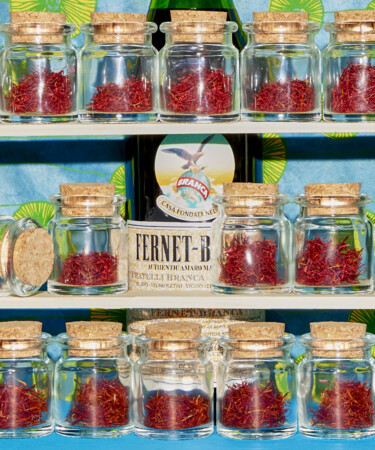The exact formulas of Italy’s historic amaros are often shrouded in mystery. Take Fernet-Branca, the world’s most popular Italian liqueur: Its recipe has been a secret since the brand’s conception in 1845. Legend has it that since Bernardino Branca founded the distillery in Milan, the recipe has remained hidden in a safe that can only be accessed by the company’s chairman, and that access is passed down through generations of founding family members. 175 years of secrecy has left room for rumors to fly about what’s in the bottle, and one particular story that has been perpetuated throughout the amaro-loving community is especially sensational: It’s been alleged that Fernet-Branca uses 75 percent of the world’s saffron output each year to produce the famous amaro.
This stat should have anyone who’s ever bought an ounce of saffron for their pantry doing a double take. Saffron is notoriously the most expensive spice in the world, and many chefs pinch their pennies just to acquire enough to make a decent paella or tagine. It’s hard to believe any brand has the means to bite off such a large piece of the spice market — especially to create a beverage in which saffron is hardly noticeable. Even so, the rumors have persisted online, including one very dubious Quora thread. So, we decided to dig a little deeper.
First, let’s get back to basics: Amaro is made with a neutral base spirit and a combination of botanicals, herbs, and spices that contribute to the drink’s signature aromatic profile. The limitless number of potential ingredients and combinations creates a vast range of styles, from light and citrus-forward bottles to more brooding, intense examples. Though sometimes you can pinpoint a single flavor, like orange zest or cardamom, the expressions more frequently meld into something more cohesive, so it’s not likely you’ll figure out what’s inside the bottle simply by tasting it. Each expression offers something different, and when brands like Fernet-Branca have spent centuries perfecting their flavor profiles, that’s something worth protecting. The Fernet-Branca website mentions that its signature bottle includes 27 herbs, roots, and spices (and even reveals what 10 of those ingredients are) but doesn’t dare to expose any more of its one-of-a-kind formula.
When VinePair reached out to Fernet-Branca for comment, the brand wouldn’t confirm exact measurements for the amaro’s ingredients, but did confirm that saffron is, indeed, a key component of the blend.
“We are not able to speak on the total worldwide output of saffron. What we can confirm and explain is that Fratelli Branca steadfastly upholds the legacy of Fernet-Branca, a prestigious blend established in 1845 that comprises 27 distinct herbs and spices, with saffron being a key component,” Heidi Chen, vice president of marketing for Branca USA, tells VinePair. “Our enduring relationships with reputable vendors are a testament to our unwavering focus on maintaining the exceptional quality and authenticity of our product. While we cannot ascertain if we account for more than 75 percent of the world’s saffron consumption, we would like to emphasize its continued importance in our premium formulation.”
With the Fernet team’s impenetrable dedication to the secret formula, we were forced to attempt some calculations of our own to see if obtaining and using this much saffron would actually be possible. There isn’t a ton of available data on Fernet-Branca production or global saffron output, so please bear with us through some shaky math.
Let’s first establish that, though the amaro’s bottle price varies based on different retail shop locations, after averaging out the typical cost, we’re working under the assumption that one liter of Fernet is worth approximately $40. We’re also using a data point that suggests the world output of saffron is about 300 tons per year, and this is a conservative estimate. So, if Fernet-Branca were to use 75 percent of the total saffron made in a year, that would equate to about 225 tons. That’s a lot of saffron, and that would mean leaving little for remaining consumers.
Another tricky piece of this puzzle is that the price of saffron can widely vary. Online quotes range from $500 a pound to upwards of $10,000 per pound depending on quality. The Fernet-Branca team did mention that the brand has great relationships with its suppliers, so for math’s sake, let’s assume they’re getting these precious threads at a pretty good deal, for around $500 per pound. If the distillery is purchasing 225 tons of saffron at $500 a pound, it would be spending $225 million on saffron each year.
This seems like a huge amount of money to spend on a mostly undetectable ingredient, but Fernet-Branca is a large company, so let’s see if it aligns with its sales data. In 2021, The Spirits Business reported that the company sold 4.5 million nine-liter cases of Fernet in 2020, which is equivalent to 40.5 million liters total. At $40 a liter, the brand would be generating about $1.6 billion in revenue a year from Fernet sales. That means the company would be using $225 million of its $1.6 billion in revenue to buy just one of the 27 herbs and spices used in the amaro’s recipe.
Even by our rough guesstimate, this theory just doesn’t seem to add up. While saffron likely adds complexity to the amaro’s flavor profile, it isn’t one of the primary notes that one notices when sipping a glass neat, and there are 26 other ingredients in the bottle worth investing in. For now, let’s consider this myth busted.
